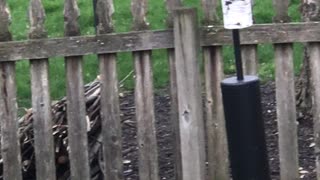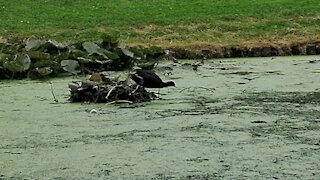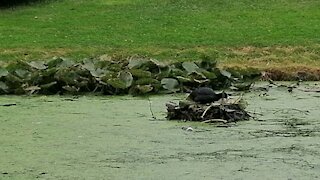Bird Nest Building Hilariously Gone Wrong
An Osprey while building its nest and positioning the sticks and twigs it collected. One of the sticks got entangled around its neck. This scene is hilarious as it fights to remove it from around its body and put it in place to make the nest complete. Check it out!
Osprey, (Pandion haliaetus), also called fish hawk, large, long-winged hawk, about 65 cm (26 inches) long, that lives along seacoasts and larger interior waterways, where it catches fish. It is brown above and white below, with some white on the head.
An osprey flies over the water to hunt. It hovers above its prey and then plunges feet first to seize a fish in its long, curved talons. With a grip secured by sharp spicules on the underside of the toes, the bird carries its prey to a favourite perch to feed. Sometimes after feeding the osprey flies low over the water, dragging its feet as if to wash them.
OSPREY
Home
Science
Birds, Reptiles & Other Vertebrates
Birds
Osprey
bird
BY The Editors of Encyclopaedia Britannica View Edit History
FULL ARTICLE
Osprey, (Pandion haliaetus), also called fish hawk, large, long-winged hawk, about 65 cm (26 inches) long, that lives along seacoasts and larger interior waterways, where it catches fish. It is brown above and white below, with some white on the head.
Ospreys (Pandion haliaetus).
See all media
Related Topics: Hawk
Watch a male osprey catching a fish and taking it to his partner, who is incubating
Watch a male osprey catching a fish and taking it to his partner, who is incubating
A male osprey catching a fish and carrying it to his mate, who is incubating eggs.
Contunico © ZDF Enterprises GmbH, Mainz
See all videos for this article
An osprey flies over the water to hunt. It hovers above its prey and then plunges feet first to seize a fish in its long, curved talons. With a grip secured by sharp spicules on the underside of the toes, the bird carries its prey to a favourite perch to feed. Sometimes after feeding the osprey flies low over the water, dragging its feet as if to wash them.
Osprey catching a fish.
Osprey catching a fish.
© Index Open
Chicken. Gallus gallus. Poultry. Fowl. Animal. Bird. Rooster. Cocks. Hens. Beak. Wattle. Comb. Farm animal. Livestock. Close-up profile of a hen's head.
BRITANNICA QUIZ
Birds, Birds, Birds Quiz
Which birds were released in Central Park in 1890 and 1891 by Shakespeare enthusiasts? Which birds lay their eggs in a chamber at the back of a burrow dug into an earth bank? Test your knowledge. Take the quiz.
The ospreys’ extensive breeding range extends to all the continents except South America (where it occurs widely in winter) and the Antarctic. The North American population declined greatly after 1947 because of the eggshell-thinning effects of DDT residues but began to recover after the pesticide was banned in 1972. Exterminated from the British Isles by 1910, the osprey reappeared there as a successfully breeding species in the 1950s and is now firmly reestablished in Scotland.
Single nests or colonies are built in tall trees, on the ground on small islands, or on ledges of cliffs. The nest is a bulky structure, up to 2 metres (6.6 feet) across, composed of haphazardly arranged sticks. The same nests may be used by many generations of birds, becoming huge in the process. Two to four white eggs marked boldly with dark brown blotches are laid. Downy young hatch in about five weeks and are fed by both parents. The young birds fledge in six to eight weeks.
The osprey is the only species in the family Pandionidae, which is sometimes considered a subfamily (Pandioninae) of the hawk and eagle family, Accipitridae, of the order Falconiformes.
-
 1:37
1:37
Expert Videos Magnetic Media
2 years agoDolphin kisses a little girl and brings her a gift
39344 -
 0:18
0:18
ViralHog
2 years ago $0.10 earnedBird Gathers Nest Building Supplies
2722 -
 0:04
0:04
backyardblessings
2 years agoBluebird nest building
23 -
 0:38
0:38
Moe2025
2 years agoDuck building a nest on a pond
18 -
 0:29
0:29
ShaghAlavi
2 years agoA spectacular scene of a duck building a nest
19 -
 2:24
2:24
Sharna
2 years agoBunny building nest on lawn
93 -
 5:56
5:56
Sharna
2 years agoCute cottontail bunny building a nest
1061 -
 1:37:32
1:37:32
2 MIKES LIVE
14 hours ago#62 2ML Join us to breakdown all the news worth mentioning!
39.5K15 -
 1:52:59
1:52:59
The Big Mig™
1 day agoTommy Victorious Robinson, Round II
34.5K27 -
 2:03:19
2:03:19
Quite Frankly
11 hours ago"From IN-SHADOW to the KINGDOM" ft Lubomir Arsov 5/6/24
34.3K10